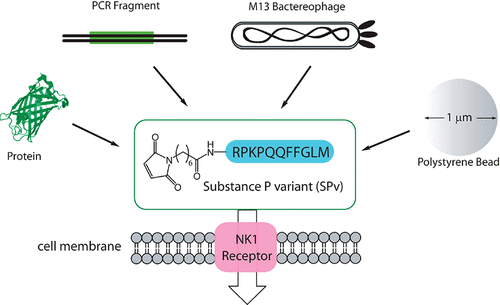Publications
View by year
- Publications: 2025
- Publications: 2024
- Publications: 2023
- Publications: 2022
- Publications: 2021
- Publications: 2020
- Publications: 2019
- Publications: 2018
- Publications: 2017
- Publications: 2016
- Publications: 2015
- Publications: 2014
- Publications: 2013
- Publications: 2012
Search
Search for author, keywords, or any other term.
Yang, Cindy F; Chiang, Michael C; Gray, Daniel C; Prabhakaran, Mahalakshmi; Alvarado, Maricruz; Juntti, Scott A; Unger, Elizabeth K; Wells, James A; Shah, Nirao M
Sexually dimorphic neurons in the ventromedial hypothalamus govern mating in both sexes and aggression in males Journal Article
In: Cell, vol. 153, no. 4, pp. 896–909, 2013, ISSN: 1097-4172.
@article{pmid23663785,
title = {Sexually dimorphic neurons in the ventromedial hypothalamus govern mating in both sexes and aggression in males},
author = {Cindy F Yang and Michael C Chiang and Daniel C Gray and Mahalakshmi Prabhakaran and Maricruz Alvarado and Scott A Juntti and Elizabeth K Unger and James A Wells and Nirao M Shah},
doi = {10.1016/j.cell.2013.04.017},
issn = {1097-4172},
year = {2013},
date = {2013-05-01},
urldate = {2013-05-01},
journal = {Cell},
volume = {153},
number = {4},
pages = {896--909},
abstract = {Sexual dimorphisms in the brain underlie behavioral sex differences, but the function of individual sexually dimorphic neuronal populations is poorly understood. Neuronal sexual dimorphisms typically represent quantitative differences in cell number, gene expression, or other features, and it is unknown whether these dimorphisms control sex-typical behavior exclusively in one sex or in both sexes. The progesterone receptor (PR) controls female sexual behavior, and we find many sex differences in number, distribution, or projections of PR-expressing neurons in the adult mouse brain. Using a genetic strategy we developed, we have ablated one such dimorphic PR-expressing neuronal population located in the ventromedial hypothalamus (VMH). Ablation of these neurons in females greatly diminishes sexual receptivity. Strikingly, the corresponding ablation in males reduces mating and aggression. Our findings reveal the functions of a molecularly defined, sexually dimorphic neuronal population in the brain. Moreover, we show that sexually dimorphic neurons can control distinct sex-typical behaviors in both sexes.},
keywords = {},
pubstate = {published},
tppubtype = {article}
}
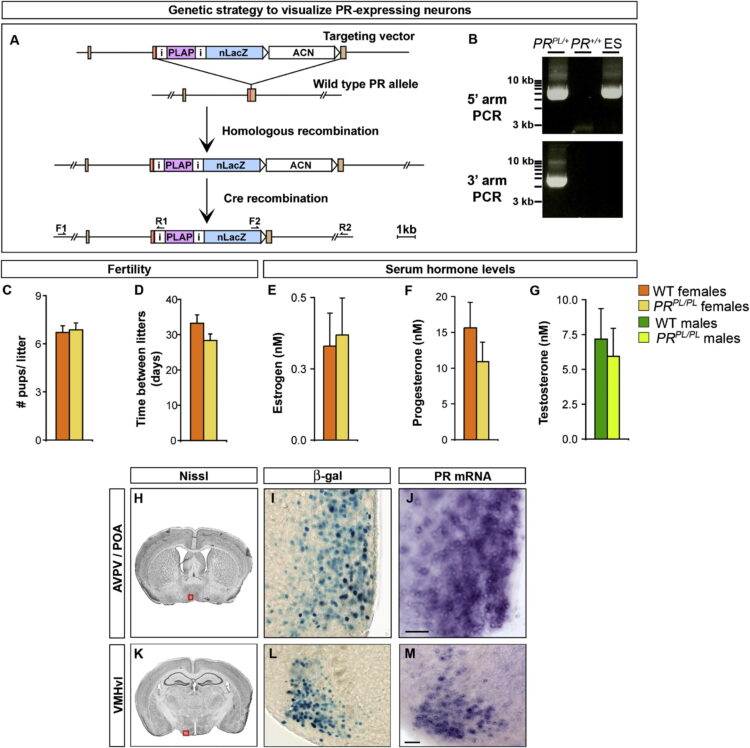
Thomsen, Nathan D; Koerber, James T; Wells, James A
Structural snapshots reveal distinct mechanisms of procaspase-3 and -7 activation Journal Article
In: Proc Natl Acad Sci U S A, vol. 110, no. 21, pp. 8477–8482, 2013, ISSN: 1091-6490.
@article{pmid23650375,
title = {Structural snapshots reveal distinct mechanisms of procaspase-3 and -7 activation},
author = {Nathan D Thomsen and James T Koerber and James A Wells},
doi = {10.1073/pnas.1306759110},
issn = {1091-6490},
year = {2013},
date = {2013-05-01},
urldate = {2013-05-01},
journal = {Proc Natl Acad Sci U S A},
volume = {110},
number = {21},
pages = {8477--8482},
abstract = {Procaspase-3 (P3) and procaspase-7 (P7) are activated through proteolytic maturation to form caspase-3 (C3) and caspase-7 (C7), respectively, which serve overlapping but nonredundant roles as the executioners of apoptosis in humans. However, it is unclear if differences in P3 and P7 maturation mechanisms underlie their unique biological functions, as the structure of P3 remains unknown. Here, we report structures of P3 in a catalytically inactive conformation, structures of P3 and P7 bound to covalent peptide inhibitors that reveal the active conformation of the zymogens, and the structure of a partially matured C7:P7 heterodimer. Along with a biochemical analysis, we show that P3 is catalytically inactive and matures through a symmetric all-or-nothing process. In contrast, P7 contains latent catalytic activity and matures through an asymmetric and tiered mechanism, suggesting a lower threshold for activation. Finally, we use our structures to design a selection strategy for conformation specific antibody fragments that stimulate procaspase activity, showing that executioner procaspase conformational equilibrium can be rationally modulated. Our studies provide a structural framework that may help to explain the unique roles of these important proapoptotic enzymes, and suggest general strategies for the discovery of proenzyme activators.},
keywords = {},
pubstate = {published},
tppubtype = {article}
}
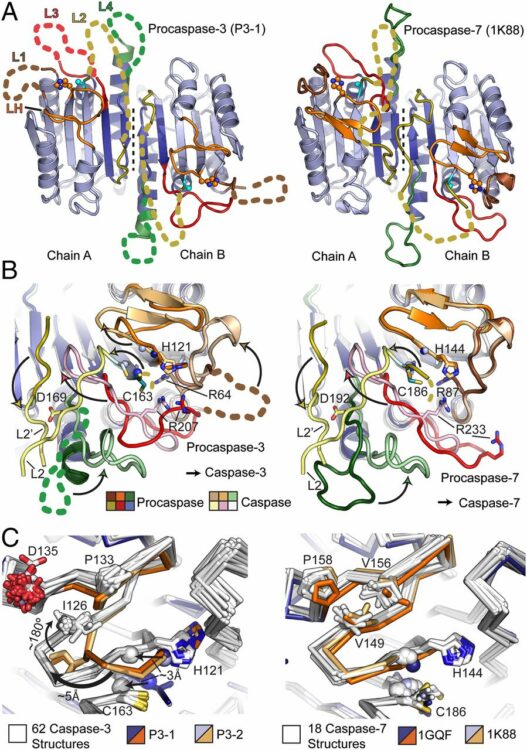
Datta, Debajyoti; McClendon, Christopher L; Jacobson, Matthew P; Wells, James A
Substrate and inhibitor-induced dimerization and cooperativity in caspase-1 but not caspase-3 Journal Article
In: J Biol Chem, vol. 288, no. 14, pp. 9971–9981, 2013, ISSN: 1083-351X.
@article{pmid23386603,
title = {Substrate and inhibitor-induced dimerization and cooperativity in caspase-1 but not caspase-3},
author = {Debajyoti Datta and Christopher L McClendon and Matthew P Jacobson and James A Wells},
doi = {10.1074/jbc.M112.426460},
issn = {1083-351X},
year = {2013},
date = {2013-04-01},
urldate = {2013-04-01},
journal = {J Biol Chem},
volume = {288},
number = {14},
pages = {9971--9981},
abstract = {Caspases are intracellular cysteine-class proteases with aspartate specificity that is critical for driving processes as diverse as the innate immune response and apoptosis, exemplified by caspase-1 and caspase-3, respectively. Interestingly, caspase-1 cleaves far fewer cellular substrates than caspase-3 and also shows strong positive cooperativity between the two active sites of the homodimer, unlike caspase-3. Biophysical and kinetic studies here present a molecular basis for this difference. Analytical ultracentrifugation experiments show that mature caspase-1 exists predominantly as a monomer under physiological concentrations that undergoes dimerization in the presence of substrate; specifically, substrate binding shifts the KD for dimerization by 20-fold. We have created a hemi-active site-labeled dimer of caspase-1, where one site is blocked with the covalent active site inhibitor, benzyloxycarbonyl-Val-Ala-Asp-fluoromethylketone. This hemi-labeled enzyme is about 9-fold more active than the apo-dimer of caspase-1. These studies suggest that substrate not only drives dimerization but also, once bound to one site in the dimer, promotes an active conformation in the other monomer. Steady-state kinetic analysis and modeling independently support this model, where binding of one substrate molecule not only increases substrate binding in preformed dimers but also drives the formation of heterodimers. Thus, the cooperativity in caspase-1 is driven both by substrate-induced dimerization as well as substrate-induced activation. Substrate-induced dimerization and activation seen in caspase-1 and not in caspase-3 may reflect their biological roles. Whereas caspase-1 cleaves a dramatically smaller number of cellular substrates that need to be concentrated near inflammasomes, caspase-3 is a constitutively active dimer that cleaves many more substrates located diffusely throughout the cell.},
keywords = {},
pubstate = {published},
tppubtype = {article}
}
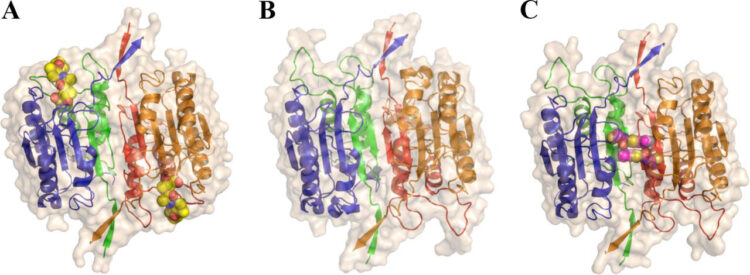
Paduch, Marcin; Koide, Akiko; Uysal, Serdar; Rizk, Shahir S; Koide, Shohei; Kossiakoff, Anthony A
Generating conformation-specific synthetic antibodies to trap proteins in selected functional states Journal Article
In: Methods, vol. 60, no. 1, pp. 3–14, 2013, ISSN: 1095-9130.
@article{pmid23280336,
title = {Generating conformation-specific synthetic antibodies to trap proteins in selected functional states},
author = {Marcin Paduch and Akiko Koide and Serdar Uysal and Shahir S Rizk and Shohei Koide and Anthony A Kossiakoff},
doi = {10.1016/j.ymeth.2012.12.010},
issn = {1095-9130},
year = {2013},
date = {2013-03-01},
urldate = {2013-03-01},
journal = {Methods},
volume = {60},
number = {1},
pages = {3--14},
abstract = {A set of phage display sorting strategies and validation methodologies are presented that are capable of producing high performance synthetic antibodies (sABs) with customized properties. Exquisite control of antigen and conditions during the phage display selection process can yield sABs that: (1) recognize conformational states, (2) target specific regions of the surface of a protein, (3) induce conformational changes, and (4) capture and stabilize multi-protein complexes. These unique capabilities open myriad opportunities to study complex macromolecular processes inaccessible to traditional affinity reagent technology. We present detailed protocols for de novo isolation of binders, as well as examples of downstream biophysical characterization. The methods described are generalizable and can be adapted to other in vitro direct evolution approaches based on yeast or mRNA display.},
keywords = {},
pubstate = {published},
tppubtype = {article}
}
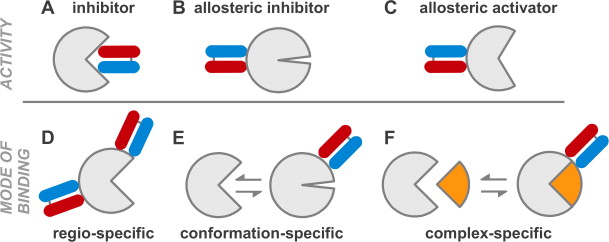
Wang, Ningkun; Majmudar, Chinmay Y; Pomerantz, William C; Gagnon, Jessica K; Sadowsky, Jack D; Meagher, Jennifer L; Johnson, Taylor K; Stuckey, Jeanne A; Brooks, Charles L; Wells, James A; Mapp, Anna K
Ordering a dynamic protein via a small-molecule stabilizer Journal Article
In: J Am Chem Soc, vol. 135, no. 9, pp. 3363–3366, 2013, ISSN: 1520-5126.
@article{pmid23384013,
title = {Ordering a dynamic protein via a small-molecule stabilizer},
author = {Ningkun Wang and Chinmay Y Majmudar and William C Pomerantz and Jessica K Gagnon and Jack D Sadowsky and Jennifer L Meagher and Taylor K Johnson and Jeanne A Stuckey and Charles L Brooks and James A Wells and Anna K Mapp},
doi = {10.1021/ja3122334},
issn = {1520-5126},
year = {2013},
date = {2013-03-01},
urldate = {2013-03-01},
journal = {J Am Chem Soc},
volume = {135},
number = {9},
pages = {3363--3366},
abstract = {Like many coactivators, the GACKIX domain of the master coactivator CBP/p300 recognizes transcriptional activators of diverse sequence composition via dynamic binding surfaces. The conformational dynamics of GACKIX that underlie its function also render it especially challenging for structural characterization. We have found that the ligand discovery strategy of Tethering is an effective method for identifying small-molecule fragments that stabilize the GACKIX domain, enabling for the first time the crystallographic characterization of this important motif. The 2.0 Å resolution structure of GACKIX complexed to a small molecule was further analyzed by molecular dynamics simulations, which revealed the importance of specific side-chain motions that remodel the activator binding site in order to accommodate binding partners of distinct sequence and size. More broadly, these results suggest that Tethering can be a powerful strategy for identifying small-molecule stabilizers of conformationally malleable proteins, thus facilitating their structural characterization and accelerating the discovery of small-molecule modulators.},
keywords = {},
pubstate = {published},
tppubtype = {article}
}
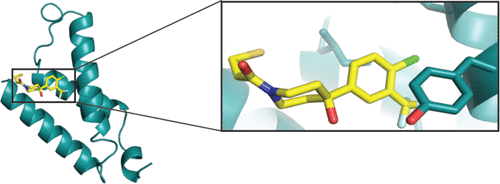
Crawford, Emily D; Seaman, Julia E; Agard, Nick; Hsu, Gerald W; Julien, Olivier; Mahrus, Sami; Nguyen, Huy; Shimbo, Kazutaka; Yoshihara, Hikari A I; Zhuang, Min; Chalkley, Robert J; Wells, James A
The DegraBase: a database of proteolysis in healthy and apoptotic human cells Journal Article
In: Mol Cell Proteomics, vol. 12, no. 3, pp. 813–824, 2013, ISSN: 1535-9484.
@article{pmid23264352,
title = {The DegraBase: a database of proteolysis in healthy and apoptotic human cells},
author = {Emily D Crawford and Julia E Seaman and Nick Agard and Gerald W Hsu and Olivier Julien and Sami Mahrus and Huy Nguyen and Kazutaka Shimbo and Hikari A I Yoshihara and Min Zhuang and Robert J Chalkley and James A Wells},
doi = {10.1074/mcp.O112.024372},
issn = {1535-9484},
year = {2013},
date = {2013-03-01},
urldate = {2013-03-01},
journal = {Mol Cell Proteomics},
volume = {12},
number = {3},
pages = {813--824},
abstract = {Proteolysis is a critical post-translational modification for regulation of cellular processes. Our lab has previously developed a technique for specifically labeling unmodified protein N termini, the α-aminome, using the engineered enzyme, subtiligase. Here we present a database, called the DegraBase (http://wellslab.ucsf.edu/degrabase/), which compiles 8090 unique N termini from 3206 proteins directly identified in subtiligase-based positive enrichment mass spectrometry experiments in healthy and apoptotic human cell lines. We include both previously published and unpublished data in our analysis, resulting in a total of 2144 unique α-amines identified in healthy cells, and 6990 in cells undergoing apoptosis. The N termini derive from three general categories of proteolysis with respect to cleavage location and functional role: translational N-terminal methionine processing (∼10% of total proteolysis), sites close to the translational N terminus that likely represent removal of transit or signal peptides (∼25% of total), and finally, other endoproteolytic cuts (∼65% of total). Induction of apoptosis causes relatively little change in the first two proteolytic categories, but dramatic changes are seen in endoproteolysis. For example, we observed 1706 putative apoptotic caspase cuts, more than double the total annotated sites in the CASBAH and MEROPS databases. In the endoproteolysis category, there are a total of nearly 3000 noncaspase nontryptic cleavages that are not currently reported in the MEROPS database. These studies significantly increase the annotation for all categories of proteolysis in human cells and allow public access for investigators to explore interesting proteolytic events in healthy and apoptotic human cells.},
keywords = {},
pubstate = {published},
tppubtype = {article}
}
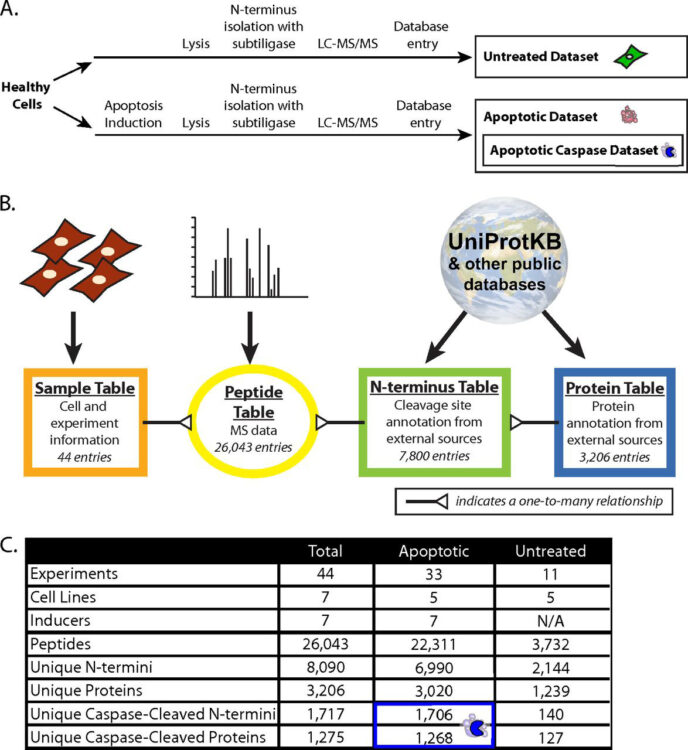
Persson, Helena; Ye, Wei; Wernimont, Amy; Adams, Jarrett J; Koide, Akiko; Koide, Shohei; Lam, Robert; Sidhu, Sachdev S
CDR-H3 diversity is not required for antigen recognition by synthetic antibodies Journal Article
In: J Mol Biol, vol. 425, no. 4, pp. 803–811, 2013, ISSN: 1089-8638.
@article{pmid23219464,
title = {CDR-H3 diversity is not required for antigen recognition by synthetic antibodies},
author = {Helena Persson and Wei Ye and Amy Wernimont and Jarrett J Adams and Akiko Koide and Shohei Koide and Robert Lam and Sachdev S Sidhu},
doi = {10.1016/j.jmb.2012.11.037},
issn = {1089-8638},
year = {2013},
date = {2013-02-01},
urldate = {2013-02-01},
journal = {J Mol Biol},
volume = {425},
number = {4},
pages = {803--811},
abstract = {A synthetic phage-displayed antibody repertoire was constructed with equivalent chemical diversity in the third complementarity-determining regions of the heavy (CDR-H3) and light (CDR-L3) chains, which contrasts with natural antibodies in which CDR-H3 is much more diverse than CDR-L3 due to the genetic mechanisms that generate antibody encoding genes. Surprisingly, the synthetic repertoire yielded numerous functional antibodies that contained mutated CDR-L3 sequences but a fixed CDR-H3 sequence. Alanine-scanning analysis of antibodies that recognized 10 different antigens but contained a common CDR-H3 loop showed that, in most cases, the fixed CDR-H3 sequence was able to contribute favorably to antigen recognition, but in some cases, the loop was functionally inert. Structural analysis of one such antibody in complex with antigen showed that the inert CDR-H3 loop was nonetheless highly buried at the antibody-antigen interface. Taken together, these results show that CDR-H3 diversity is not necessarily required for the generation of antibodies that recognize diverse protein antigens with high affinity and specificity, and if given the chance, CDR-L3 readily assumes the dominant role for antigen recognition. These results contrast with the commonly accepted view of antigen recognition derived from the analysis of natural antibodies, in which CDR-H3 is presumed to be dominant and CDR-L3 is presumed to play an auxiliary role. Furthermore, the results show that natural antibody function is genetically constrained, and it should be possible to develop more functional synthetic antibody libraries by expanding the diversity of CDR-L3 beyond what is observed in nature.},
keywords = {},
pubstate = {published},
tppubtype = {article}
}
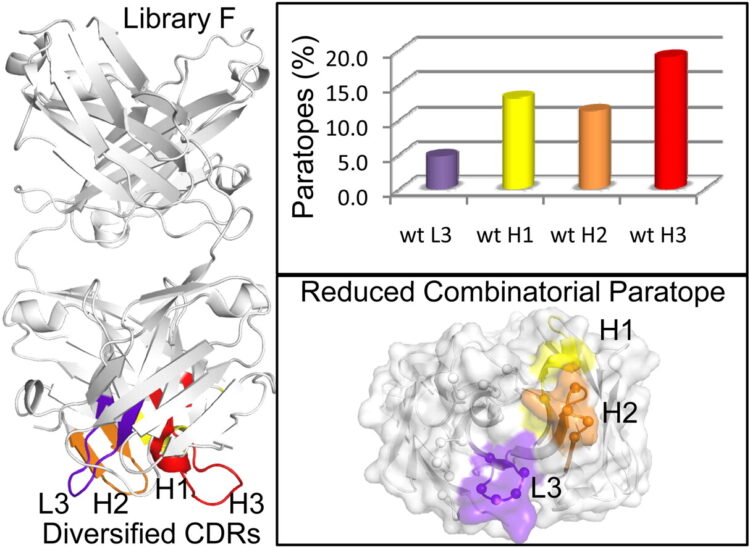
Zhuang, Min; Guan, Shenheng; Wang, Haopeng; Burlingame, Alma L; Wells, James A
Substrates of IAP ubiquitin ligases identified with a designed orthogonal E3 ligase, the NEDDylator Journal Article
In: Mol Cell, vol. 49, no. 2, pp. 273–282, 2013, ISSN: 1097-4164.
@article{pmid23201124,
title = {Substrates of IAP ubiquitin ligases identified with a designed orthogonal E3 ligase, the NEDDylator},
author = {Min Zhuang and Shenheng Guan and Haopeng Wang and Alma L Burlingame and James A Wells},
doi = {10.1016/j.molcel.2012.10.022},
issn = {1097-4164},
year = {2013},
date = {2013-01-01},
urldate = {2013-01-01},
journal = {Mol Cell},
volume = {49},
number = {2},
pages = {273--282},
abstract = {Inhibitors of Apoptosis Protein (IAPs) are guardian ubiquitin ligases that keep classic proapoptotic proteins in check. Systematic identification of additional IAP substrates is challenged by the heterogeneity and sheer number of ubiquitinated proteins (>5,000). Here we report a powerful catalytic tagging tool, the NEDDylator, which fuses a NEDD8 E2-conjugating enzyme, Ubc12, to the ubiquitin ligase, XIAP or cIAP1. This permits transfer of the rare ubiquitin homolog NEDD8 to the ubiquitin E3 substrates, allowing them to be efficiently purified for LC-MS/MS identification. We have identified >50 potential IAP substrates of both cytosolic and mitochondrial origin that bear hallmark N-terminal IAP binding motifs. These substrates include the recently discovered protein phosphatase PGAM5, which we show is proteolytically processed, accumulates in cytosol during apoptosis, and sensitizes cells to death. These studies reveal mechanisms and antagonistic partners for specific IAPs, and provide a powerful technology for labeling binding partners in transient protein-protein complexes.},
keywords = {},
pubstate = {published},
tppubtype = {article}
}
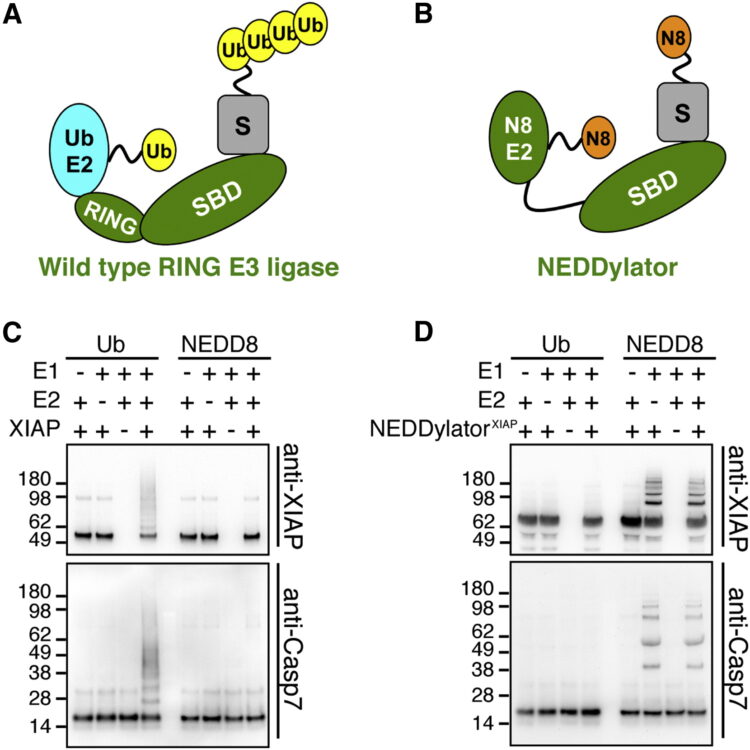
Crawford, E D; Seaman, J E; Barber, A E; David, D C; Babbitt, P C; Burlingame, A L; Wells, J A
In: Cell Death Differ, vol. 19, no. 12, pp. 2040–2048, 2012, ISSN: 1476-5403.
@article{pmid22918439,
title = {Conservation of caspase substrates across metazoans suggests hierarchical importance of signaling pathways over specific targets and cleavage site motifs in apoptosis},
author = {E D Crawford and J E Seaman and A E Barber and D C David and P C Babbitt and A L Burlingame and J A Wells},
doi = {10.1038/cdd.2012.99},
issn = {1476-5403},
year = {2012},
date = {2012-12-01},
urldate = {2012-12-01},
journal = {Cell Death Differ},
volume = {19},
number = {12},
pages = {2040--2048},
abstract = {Caspases, cysteine proteases with aspartate specificity, are key players in programmed cell death across the metazoan lineage. Hundreds of apoptotic caspase substrates have been identified in human cells. Some have been extensively characterized, revealing key functional nodes for apoptosis signaling and important drug targets in cancer. But the functional significance of most cuts remains mysterious. We set out to better understand the importance of caspase cleavage specificity in apoptosis by asking which cleavage events are conserved across metazoan model species. Using N-terminal labeling followed by mass spectrometry, we identified 257 caspase cleavage sites in mouse, 130 in Drosophila, and 50 in Caenorhabditis elegans. The large majority of the caspase cut sites identified in mouse proteins were found conserved in human orthologs. However, while many of the same proteins targeted in the more distantly related species were cleaved in human orthologs, the exact sites were often different. Furthermore, similar functional pathways are targeted by caspases in all four species. Our data suggest a model for the evolution of apoptotic caspase specificity that highlights the hierarchical importance of functional pathways over specific proteins, and proteins over their specific cleavage site motifs.},
keywords = {},
pubstate = {published},
tppubtype = {article}
}
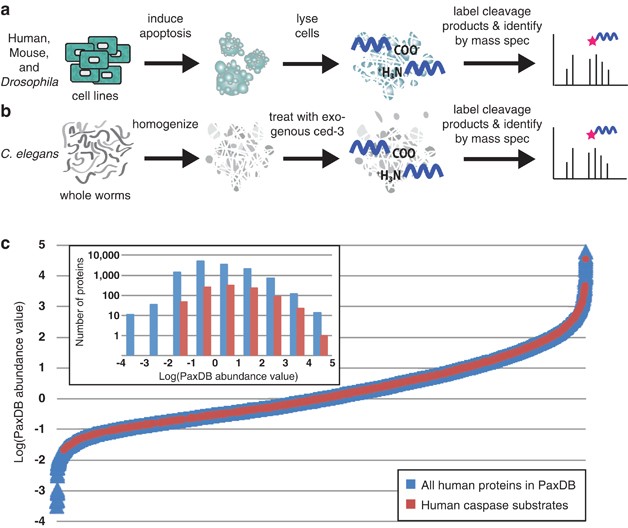
Zorn, Julie A; Wolan, Dennis W; Agard, Nicholas J; Wells, James A
Fibrils colocalize caspase-3 with procaspase-3 to foster maturation Journal Article
In: J Biol Chem, vol. 287, no. 40, pp. 33781–33795, 2012, ISSN: 1083-351X.
@article{pmid22872644,
title = {Fibrils colocalize caspase-3 with procaspase-3 to foster maturation},
author = {Julie A Zorn and Dennis W Wolan and Nicholas J Agard and James A Wells},
doi = {10.1074/jbc.M112.386128},
issn = {1083-351X},
year = {2012},
date = {2012-09-01},
urldate = {2012-09-01},
journal = {J Biol Chem},
volume = {287},
number = {40},
pages = {33781--33795},
abstract = {Most proteases are expressed as inactive precursors, or zymogens, that become activated by limited proteolysis. We previously identified a small molecule, termed 1541, that dramatically promotes the maturation of the zymogen, procaspase-3, to its mature form, caspase-3. Surprisingly, compound 1541 self-assembles into nanofibrils, and localization of procaspase-3 to the fibrils promotes activation. Here, we interrogate the biochemical mechanism of procaspase-3 activation on 1541 fibrils in addition to proteogenic amyloid-β(1-40) fibrils. In contrast to previous reports, we find no evidence that procaspase-3 alone is capable of self-activation, consistent with its fate-determining role in executing apoptosis. In fact, mature caspase-3 is >10(7)-fold more active than procaspase-3, making this proenzyme a remarkably inactive zymogen. However, we also show that fibril-induced colocalization of trace amounts of caspase-3 or other initiator proteases with procaspase-3 dramatically stimulates maturation of the proenzyme in vitro. Thus, similar to known cellular signaling complexes, these synthetic or natural fibrils can serve as platforms to concentrate procaspase-3 for trans-activation by upstream proteases.},
keywords = {},
pubstate = {published},
tppubtype = {article}
}
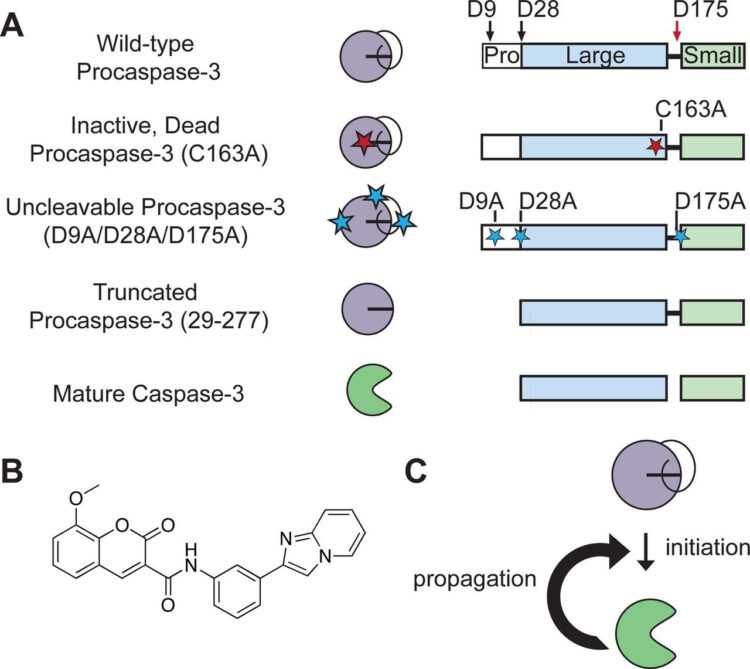
Shimbo, Kazutaka; Hsu, Gerald W; Nguyen, Huy; Mahrus, Sami; Trinidad, Jonathan C; Burlingame, Alma L; Wells, James A
Quantitative profiling of caspase-cleaved substrates reveals different drug-induced and cell-type patterns in apoptosis Journal Article
In: Proc Natl Acad Sci U S A, vol. 109, no. 31, pp. 12432–12437, 2012, ISSN: 1091-6490.
@article{pmid22802652,
title = {Quantitative profiling of caspase-cleaved substrates reveals different drug-induced and cell-type patterns in apoptosis},
author = {Kazutaka Shimbo and Gerald W Hsu and Huy Nguyen and Sami Mahrus and Jonathan C Trinidad and Alma L Burlingame and James A Wells},
doi = {10.1073/pnas.1208616109},
issn = {1091-6490},
year = {2012},
date = {2012-07-01},
urldate = {2012-07-01},
journal = {Proc Natl Acad Sci U S A},
volume = {109},
number = {31},
pages = {12432--12437},
abstract = {Proapoptotic drugs are a mainstay of cancer drug treatment. These drugs stress cells and ultimately trigger the activation of caspases, cysteine-class proteases that cleave after aspartic acid and deconstruct the cell. It is well known that cells respond differently to proapoptotic cancer drug treatments. Here, using a global and unbiased quantitative N-terminomics technology, we show that ~500 products of caspase cleavage and their kinetics vary dramatically between cell type and cytotoxic drug treatment. It is likely that variations arise from differences in baseline proteome composition of the cell type and the alterations induced by drug treatments to yield a unique cohort of proteins that caspases finally target. Many targets are specific to both drug treatment and cell type, providing candidate-specific biomarkers for apoptosis. For example, in multiple myeloma cells treated with the proteasome inhibitor bortezomib, levels of activating transcription factor-4 increase dramatically early in drug treatment and then decrease upon cleavage by activated caspases. Thus, caspase-derived cleavage products are a sensitive reflection of cell-type and drug-induced stress, and provide useful fingerprints for mechanisms of drug action and response.},
keywords = {},
pubstate = {published},
tppubtype = {article}
}
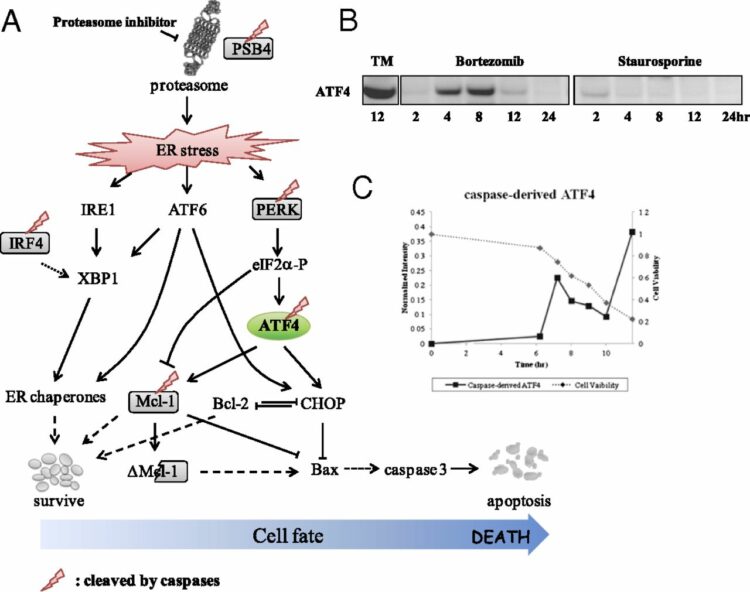
Zhang, Xulun; Hoey, Robert J; Lin, Guoqing; Koide, Akiko; Leung, Brenda; Ahn, Kwangwook; Dolios, Georgia; Paduch, Marcin; Ikeuchi, Takeshi; Wang, Rong; Li, Yue-Ming; Koide, Shohei; Sisodia, Sangram S
Identification of a tetratricopeptide repeat-like domain in the nicastrin subunit of γ-secretase using synthetic antibodies Journal Article
In: Proc Natl Acad Sci U S A, vol. 109, no. 22, pp. 8534–8539, 2012, ISSN: 1091-6490.
@article{pmid22586122,
title = {Identification of a tetratricopeptide repeat-like domain in the nicastrin subunit of γ-secretase using synthetic antibodies},
author = {Xulun Zhang and Robert J Hoey and Guoqing Lin and Akiko Koide and Brenda Leung and Kwangwook Ahn and Georgia Dolios and Marcin Paduch and Takeshi Ikeuchi and Rong Wang and Yue-Ming Li and Shohei Koide and Sangram S Sisodia},
doi = {10.1073/pnas.1202691109},
issn = {1091-6490},
year = {2012},
date = {2012-05-01},
urldate = {2012-05-01},
journal = {Proc Natl Acad Sci U S A},
volume = {109},
number = {22},
pages = {8534--8539},
abstract = {The γ-secretase complex, composed of presenilin, anterior-pharynx-defective 1, nicastrin, and presenilin enhancer 2, catalyzes the intramembranous processing of a wide variety of type I membrane proteins, including amyloid precursor protein (APP) and Notch. Earlier studies have revealed that nicastrin, a type I membrane-anchored glycoprotein, plays a role in γ-secretase assembly and trafficking and has been proposed to bind substrates. To gain more insights regarding nicastrin structure and function, we generated a conformation-specific synthetic antibody and used it as a molecular probe to map functional domains within nicastrin ectodomain. The antibody bound to a conformational epitope within a nicastrin segment encompassing residues 245-630 and inhibited the processing of APP and Notch substrates in in vitro γ-secretase activity assays, suggesting that a functional domain pertinent to γ-secretase activity resides within this region. Epitope mapping and database searches revealed the presence of a structured segment, located downstream of the previously identified DAP domain (DYIGS and peptidase; residues 261-502), that is homologous to a tetratricopeptide repeat (TPR) domain commonly involved in peptide recognition. Mutagenesis analyses within the predicted TPR-like domain showed that disruption of the signature helical structure resulted in the loss of γ-secretase activity but not the assembly of the γ-secretase and that Leu571 within the TPR-like domain plays an important role in mediating substrate binding. Taken together, these studies offer provocative insights pertaining to the structural basis for nicastrin function as a "substrate receptor" within the γ-secretase complex.},
keywords = {},
pubstate = {published},
tppubtype = {article}
}
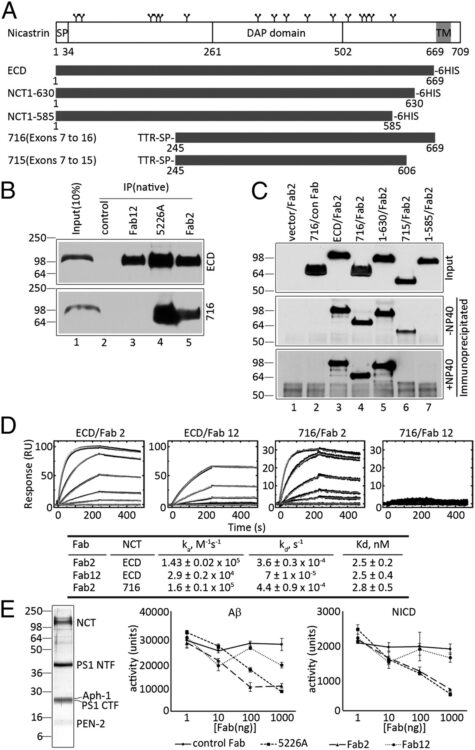
Agard, Nicholas J; Mahrus, Sami; Trinidad, Jonathan C; Lynn, Aenoch; Burlingame, Alma L; Wells, James A
Global kinetic analysis of proteolysis via quantitative targeted proteomics Journal Article
In: Proc Natl Acad Sci U S A, vol. 109, no. 6, pp. 1913–1918, 2012, ISSN: 1091-6490.
@article{pmid22308409,
title = {Global kinetic analysis of proteolysis via quantitative targeted proteomics},
author = {Nicholas J Agard and Sami Mahrus and Jonathan C Trinidad and Aenoch Lynn and Alma L Burlingame and James A Wells},
doi = {10.1073/pnas.1117158109},
issn = {1091-6490},
year = {2012},
date = {2012-02-01},
urldate = {2012-02-01},
journal = {Proc Natl Acad Sci U S A},
volume = {109},
number = {6},
pages = {1913--1918},
abstract = {Mass spectrometry-based proteomics is a powerful tool for identifying hundreds to thousands of posttranslational modifications in complex mixtures. However, it remains enormously challenging to simultaneously assess the intrinsic catalytic efficiencies (k(cat)/K(M)) of these modifications in the context of their natural interactors. Such fundamental enzymological constants are key to determining substrate specificity and for establishing the timing and importance of cellular signaling. Here, we report the use of selected reaction monitoring (SRM) for tracking proteolysis induced by human apoptotic caspases-3, -7, -8, and -9 in lysates and living cells. By following the appearance of the cleaved peptides in lysate as a function of time, we were able to determine hundreds of catalytic efficiencies in parallel. Remarkably, we find the rates of substrate hydrolysis for individual caspases vary greater than 500-fold indicating a sequential process. Moreover, the rank-order of substrate cutting is similar in apoptotic cells, suggesting that cellular structures do not dramatically alter substrate accessibility. Comparisons of extrinsic (TRAIL) and intrinsic (staurosporine) inducers of apoptosis revealed similar substrate profiles, suggesting the final proteolytic demolitions proceed by similarly ordered plans. Certain biological processes were rapidly targeted by the caspases, including multiple components of the endocyotic pathway and miRNA processing machinery. We believe this massively parallel and quantitative label-free approach to obtaining basic enzymological constants will facilitate the study of proteolysis and other posttranslational modifications in complex mixtures.},
keywords = {},
pubstate = {published},
tppubtype = {article}
}
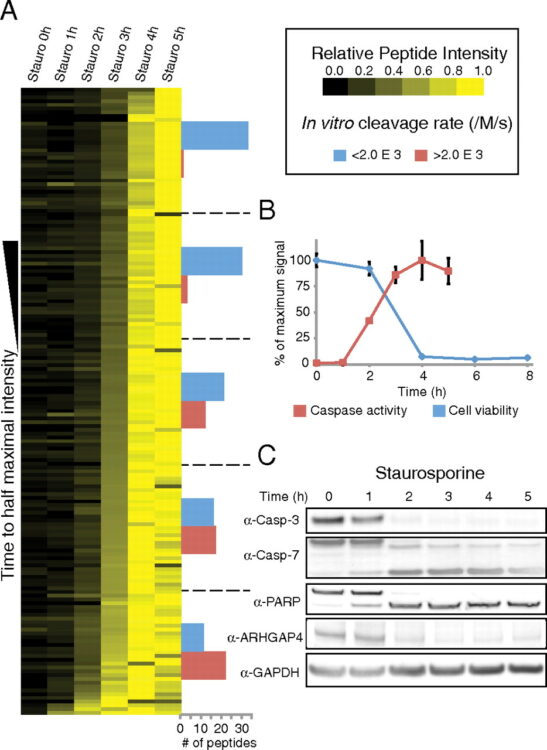
Rizk, Shahir S; Misiura, Agnieszka; Paduch, Marcin; Kossiakoff, Anthony A
Substance P derivatives as versatile tools for specific delivery of various types of biomolecular cargo Journal Article
In: Bioconjug Chem, vol. 23, no. 1, pp. 42–46, 2012, ISSN: 1520-4812.
@article{pmid22175275,
title = {Substance P derivatives as versatile tools for specific delivery of various types of biomolecular cargo},
author = {Shahir S Rizk and Agnieszka Misiura and Marcin Paduch and Anthony A Kossiakoff},
doi = {10.1021/bc200496e},
issn = {1520-4812},
year = {2012},
date = {2012-01-01},
urldate = {2012-01-01},
journal = {Bioconjug Chem},
volume = {23},
number = {1},
pages = {42--46},
abstract = {The use of proteins or nucleic acids as therapeutic agents has been severely hampered by their intrinsic inability to cross the cell membrane. Moreover, common techniques for driving the delivery of macromolecules lack the ability to distinguish between healthy and diseased tissue, precluding their clinical use. Recently, receptor-mediated delivery (RMD) has emerged as a technology with the potential to circumvent the obstacles associated with the delivery of drug targets by utilizing the natural endocytosis of a ligand upon binding to its receptor. Here, we describe the synthesis of variants of substance P (SP), an eleven amino acid neuropeptide ligand of the neurokinin type 1 receptor (NK1R), for the delivery of various types of cargo. The variants of SP were synthesized with an N-terminal maleimide moiety that allows conjugation to surface thiols, resulting in a nonreducible thioether. Cargos lacking an available thiol are conjugated to SP using commercially available cross-linkers. In addition to the delivery of proteins, we expand the use of SP to include nuclear delivery of DNA fragments that are actively expressed in the target cells. We also show that SP can be used to deliver whole bacteriophage particles as well as polystyrene beads up to 1 μm in diameter. The results show the ability of SP to deliver cargo of various sizes and chemical properties that retain their function within the cell. Furthermore, the overexpression of the NK1R in many tumors provides the potential for developing targeted delivery reagents that are specific toward diseased tissue.},
keywords = {},
pubstate = {published},
tppubtype = {article}
}
